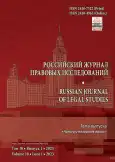A.V. Polyakov’s Communicative Theory of Law in the Conditions of the Medial Turn: Structural Points of Growth
- Authors: Tikhonova S.V.1,2
-
Affiliations:
- Saratov State University
- Saratov State Law Academy
- Issue: Vol 10, No 1 (2023)
- Pages: 37-44
- Section: Theoretical and historical legal sciences
- URL: https://journals.rcsi.science/2410-7522/article/view/131820
- DOI: https://doi.org/10.17816/RJLS181130
- ID: 131820
Cite item
Abstract
This article concerns the points of growth of A.V. Polyakov's communicative theory of law in the conditions of a medial turn. The main purpose of the A.V. Polyakov theory was to integrate various types of legal understanding, reconciling the confrontation of natural law, positivism, and sociological theories of law. The semantic core of this theory is the concept of legal communication as an interaction between legal subjects who are aware of each other's rights and recognize them. The medial turn associated with total digitalization is becoming a new challenge for the communicative theory of law. The author analyzes its nodal moments, in which it is possible to expand the heuristic potential of the theory. The starting point of the analysis is the structure of communication, the treatment of which allows one to concretize, expand, and supplement the initial provisions of the theory of A.V. Polyakov. In the part of the theory related to the consideration of communicants, A.V. Polyakov introduces the intersubjective figure of the Other, thanks to which legal communication is focused on the counterparty. However, a different figurativeness of the Other is possible here, based on the typification of polysubject communication and the combinatorics of classical forms of communication in intermediate models. The examination of the communication channel reveals the possibility of calibrating A.V. Polyakov's chosen broad understanding of the text as any set of signs included in semiosis through a narrow understanding of the text as a form of communication based on M. McLuhan's idea of communication revolutions. In this case, the prospects for research on the role of media text in the legal communication of digital society open up. The message is the material basis for transporting the meaning of legal communication. It is possible to expand the theory by analyzing the processes of interference of meaning within a single message based on the methodology of N. Luhmann's autopoiesis. The effects of legal communication can be considered more panoramically when detailing the system of communication blocks of various natures, which is conceptualized on the basis of R. Dahrendorf's theory of social conflict. Structural analysis of communication is both a strategy for detailing its features and a methodological technique for expanding theory through new projects of methodological syntheses with social theories.
Full Text
##article.viewOnOriginalSite##About the authors
Sophia V. Tikhonova
Saratov State University; Saratov State Law Academy
Author for correspondence.
Email: segedasv@yandex.ru
ORCID iD: 0000-0003-2487-3925
SPIN-code: 3813-6641
Scopus Author ID: 57191089147
ResearcherId: S-2386-2016
Doctor of Philosophy, Professor
Russian Federation, Saratov; SaratovReferences
- Antonov MV, Chestnov IL, Lukovskaya DI, Timoshina EV, editors. Kommunikativnaya teoriya prava i sovremennye problemy yurisprudencii. K 60-letiyu Andreya Vasil’evicha Polyakova. Kollektivnaya monografiya. In 2 vol. Saint Petersburg: Alef-Press, 2014. Vol. 1. 533 p; Vol. 2. 373 p. 373 p. (In Russ.).
- Vetyutnev YuYu. Morfologicheskie aspekty pravovoj kommunikacii. In: Kommunikativnaya teoriya prava i sovremennye problemy yurisprudencii. K 60-letiyu Andreya Vasil’evicha Polyakova. Kollektivnaya monografiya. In 2 vol. M.V. Antonov, I.L. Chestnov, D.I. Lukovskaya, E.V. Timoshina, eds. Vol. 1. Saint Petersburg: Alef-Press, 2014. P. 216–224. (In Russ.).
- Polyakov AV. Proshchanie s klassikoj, ili kak vozmozhna kommunikativnaya teoriya prava. Kommunikativnoe pravoponimanie. Izbrannye trudy. Saint Petersburg: Alef-Press, 2014. P. 90–135. (In Russ.).
- Buber M. Ya i Ty. Dva obraza very. Мoscow, 1995. P. 15–92. (In Russ.).
- Anohin VB, Bozhko NYu, Morozova NA. Samoreferenciya kak filosofskaya problema: kibernetika vtorogo poryadka, evolyucionnaya i radikal’naya epistemologiya, teoriya haosa. Aktual’nye problemy gumanitarnyh i estestvennyh nauk. 2009;6:94–99. (In Russ.).
- Luhmann N. Real’nost’ massmedia. Moscow: Praksis, 2005. 256 p. (In Russ.).
- Nevvazhaj ID. Klassifikacii norm v semioticheskoj koncepcii norm. Proceedings of the International scientific conference. Mir cheloveka: normativnoe izmerenie – 6. Normy myshleniya, vospriyatiya, povedeniya: skhodstvo, razlichie, vzaimosvyaz’. Saratov: SSUA, 2019. P. 38–49. (In Russ.).
- Polyakov AV. Kommunikativnaya koncepciya prava. Kommunikativnoe pravoponimanie. Izbrannye trudy. Saint- Petersburg: Alef-Press, 2014. P. 7–10. (In Russ.).
- Polyakov AV. Pravo i kommunikaciya. Kommunikativnoe pravoponimanie. Izbrannye trudy. Saint Petersburg: Alef-Press, 2014. P. 11–32. (In Russ.).
- Polyakov AV. Antropologo-kommunikativnoe obosnovanie prav cheloveka. Kommunikativnoe pravoponimanie. Izbrannye trudy. Saint Petersburg: Alef-Press, 2014. P. 33–54. (In Russ.).
- Howes D. e-Legislation: Law-Making in the Digital Age. Mcgill Law Journal / Revue De Droit De Mcgill. 2001;47:39–57.
- Fuller LL. The Morality of Law, rev. ed. New Haven: Yale University Press, 1969. 276 p.
- Chestnov IL. Perspektivy postneklassicheskoj kommunikativnoj teorii prava. In: Kommunikativnaya teoriya prava i sovremennye problemy yurisprudencii. K 60-letiyu Andreya Vasil’evicha Polyakova. Kollektivnaya monografiya. In 2 vol. M.V. Antonov, I.L. Chestnov, D.I. Lukovskaya, E.V. Timoshina, eds. Vol. 1. Saint Petersburg: Alef-Press, 2014. P. 20–32. (In Russ.).
- Hoecke van M. Pravo kak kommunikaciya. Saint Petersburg: SPbGU pbl, 2012. 288 p. (In Russ.).
- Polyakov AV. Priznanie prava i princip formal’nogo ravenstva. Proceedings of Higher Educational Institutions. Pravovedenie. 2015;6(323):55–77. (In Russ.).
- Dahrendorf R. Sovremennyj social’nyj konflikt. Inostrannaya literature. 1993;4:236–242. (In Russ.).
- Dahrendorf R. Elementy teorii social’nogo konflikta. Sociologicheskie issledovaniya. 1994;5:142–147. (In Russ.).
Supplementary files







